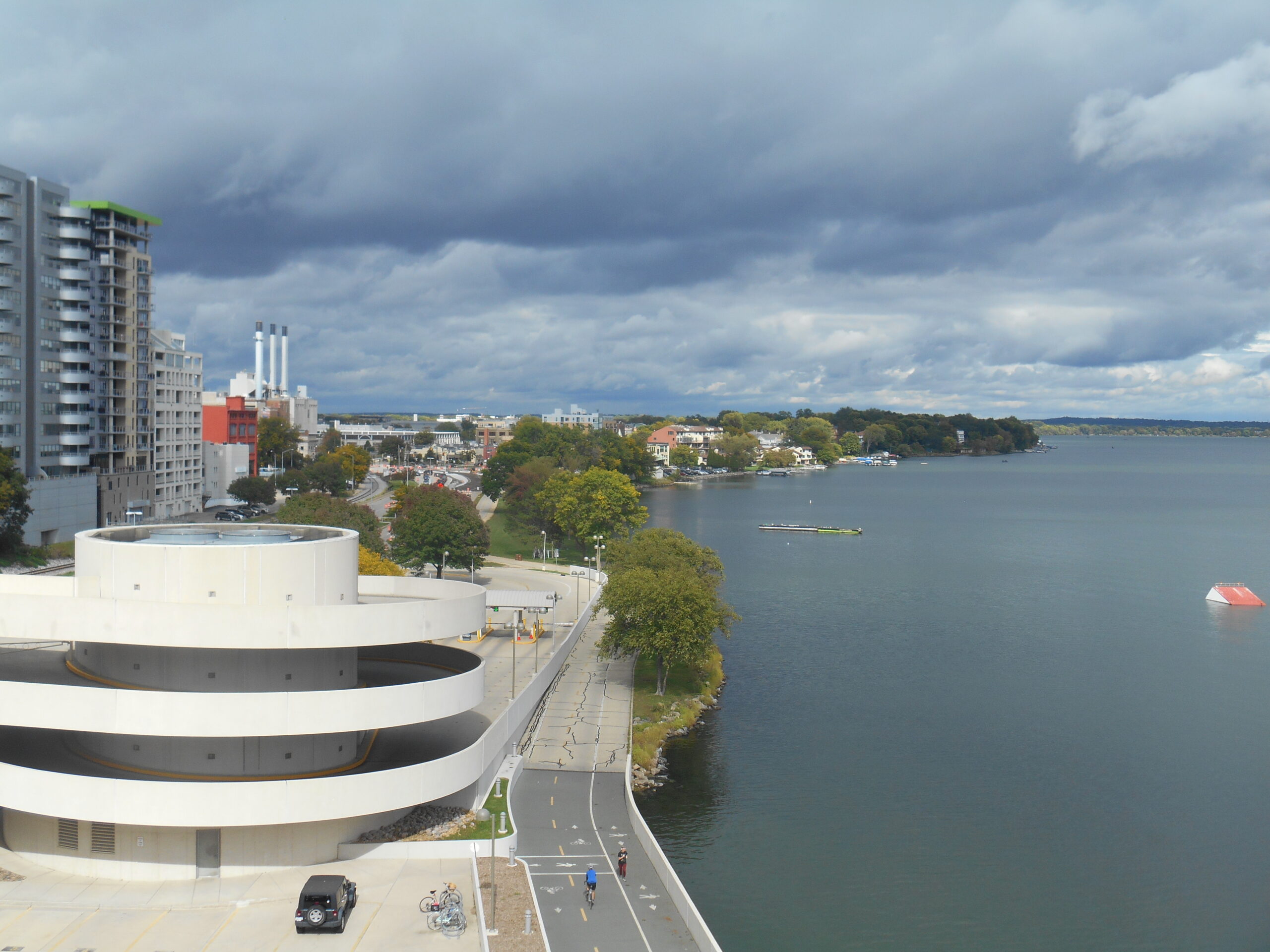[Above: View looking east from the top of Monona Terrace on Sept. 25, 2022. Photo-Maria Powell]
***
Previous posts described how, from the 1930s to the 1950s, the City of Madison filled the Lake Monona shoreline with refuse to make Law Park, and how the Frank Lloyd Wright-inspired Monona Terrace was approved there decades later.
The question put before Madison voters in the 1992 referendum on Monona Terrace was: “Shall the City of Madison construct the Frank Lloyd Wright Monona Terrace Community and Convention Center at Law Park at a total cost not to exceed $63.5 million in 1992 dollars…provided there will be no significant adverse environmental impact on Lake Monona.” The referendum narrowly passed.
The project was a State Department of Administration (DOA) and City of Madison partnership. The DOA led the Environmental Impact Statement (EIS) process required by the U.S. National Environmental Policy Act (NEPA), but a city committee guided it, selecting which parameters consultants should include (or not).
In August 1993, DOA consultants Woodward-Clyde produced the Final EIS, which concluded that the center would not have any “measurable” long term impacts on the lake.
Reassured by this, on Nov. 16, 1993, the city passed a resolution: “NOW, THEREFORE, BE IT RESOLVED that the Common Council finds that the construction of the Monona Terrace Convention and Community Center will have no significant adverse environmental impact on Lake Monona.”
Monona Terrace will “serve as a model for controlling storm water drainage and non-point source pollution.” Really?
One major (and obvious) concern about locating a large concrete structure with hundreds of parking slots right on Lake Monona is that it will exacerbate stormwater runoff into the lake. In fact, even the lame FEIS (that dismissed nearly all potential negative impacts) estimated that the center would cause significant increases of sediments, phosphorus, and lead in stormwater runoff into the lake (see previous post). But it concluded that “[a]lthough the estimated changes are large, the actual numbers are small relative to the lake’s annual pollutant load” and “would not result in a measurable impact on the overall condition of Lake Monona or on the downstream water resources.”
Some center advocates, including environmentalists, argued that the center would actually improve water quality. Caryl Terrell, head of the Sierra Club state chapter and also a city Plan Commissioner who chaired the committee that supervised the Environmental Impact Statement told the State Journal in 1992 that Monona Terrace would not exacerbate stormwater pollution, but would in fact “serve as a model for controlling storm water drainage and non-point source pollution.”**
The Common Council’s November 1993 resolution that there would be “no significant adverse environmental impact” on the lake from Monona Terrace was premised on several mitigation measures that were to be implemented in the future. They included the following stormwater management goals for the completed project: a) reduce the sediment and metals in the stormwater runoff to 20% of the estimated present load; b) Reduce oil and petroleum in the stormwater runoff to 20% of the estimated present load; c) Reduce phosphorus in the stormwater runoff to 50% of estimated present load; d) Due to the unique nature of these goals, staff shall investigate the eligibility of grants for installation and monitoring of these facilities.”
Related to (d), the council resolution, sponsored by Mayor Paul Soglin and Alders Bauman, Bigelow, and MacCubbin, estimated that “the mitigation actions proposed in the Resolution which were not included in the original project budget” would be $50,000, and a “prototype stormwater management system could cost an additional $50,000, some or all of which may be eligible for grants.”
After much controversy, the construction of Monona Terrace was begun in 1995 and completed in 1997.
Were these “model” or “prototype” stormwater control practices implemented at Monona Terrace? Were federal and state stormwater laws implemented in 1994, and updated in later years, followed? What about local stormwater ordinances? Are these model stormwater approaches (or others) still in place at Monona Terrace now? Have they been effective in reducing runoff of petroleum, lead, and other contaminants into the lake? Is anyone monitoring?
It’s hard to say. The DNR has no Monona Terrace stormwater records after the 1990s. What about the city? As when I asked for Law Park Landfill records and was told the city didn’t have any, Greg Fries, the Deputy City Engineer and head of the city’s stormwater program (who worked for the city in 1995 when the center was built), told me he couldn’t locate any stormwater records for Monona Terrace. But he is still looking.
To be continued…
******
**Hmmm. So a giant concrete structure with huge parking ramps will reduce stormwater runoff compared to the park and greenspace that were there before? See photo below (a photograph of a picture in a report in DNR files).


